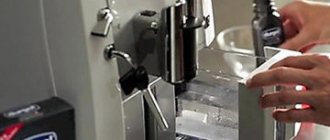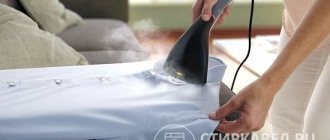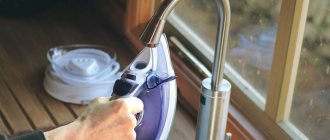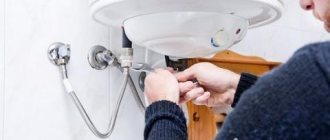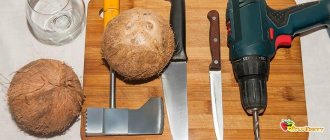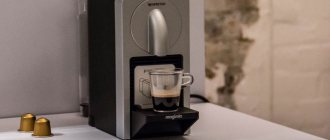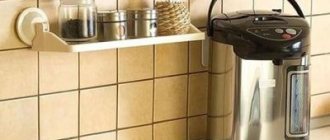Causes of scale and how to detect it
Water contains mineral salts: calcium, magnesium, phosphorus, chlorine. When coffee is brewed at a temperature of 88-95 degrees, they settle on the walls and parts of the coffee maker in the form of a sediment that does not dissolve.
Due to untimely cleaning of the device from carbon deposits and scale, a thick limescale crust appears on the inside. It forms faster from tap water.
Expert opinion
Vadim Kudryavtsev
Coffee expert, professional barista and simply in love with this aromatic drink.
Ask the barista a question
Modern models are equipped with light indication. It notifies you that it is time for cleaning. If your device does not have such a function, monitor its condition and the taste of the drink.
Signs that scale has appeared:
- the outlet is clogged, so a thin stream of drink flows out of it;
- when the device is working, it makes a lot of noise and makes uncharacteristic sounds;
- the drink has an unpleasant aftertaste and a metallic smell;
- the device is leaking;
- a gray coating appeared in the cup.
Now let’s find out how to descale a coffee maker at home.
The need for decalcification
Scale interferes with the operation of the device, clogging the water passages. The sediment gives the coffee an unpleasant aftertaste, increases energy consumption, and can lead to serious damage.
Important ! The rate of limescale formation depends on the degree of water hardness. The higher the hardness, the faster plaque forms.
Signs of limescale
Not all models of coffee makers are equipped with a sensor that signals the need for cleaning to remove deposits. Therefore, it is important to recognize the signs of device clogging in time:
- deterioration of the taste of the coffee drink;
- appearance of foreign odor;
- presence of light gray sediment;
- the finished drink flows out in an intermittent thin stream;
- increased energy consumption when using the device;
- It takes much longer to prepare a cup of coffee than it used to.
The heater and tubes of boiler-type drip and carob coffee makers quickly become overgrown with limescale. In devices with a thermoblock, water does not stagnate, so scale forms more slowly.
We clean with what we have at hand at home
Vinegar 9%
First, let's talk about how to clean a coffee maker with 9% vinegar. It contains alcohols, esters, food acids: malic, citric, which effectively dissolve scale.
Mix vinegar and water in a 1:2 ratio. Pour liquid into the water container and turn on the device. Wait for the water to boil and leave the coffee maker for 10-12 hours.
Interesting! Electric Turks with automatic shut-off when boiling
Then pour out the cleaning solution and rinse the device with warm water.
The next stage is running the liquid. Prepare 4-5 cups of coffee. Don't drink it - throw it away, otherwise you'll get poisoned.
If you don't rinse off the water, vinegar residue will settle on the parts. The drink will acquire an unpleasant taste and sour smell.
Have you tried using vinegar?
Not really
Lemon acid
Now about how to clean a coffee maker with citric acid. Pour 2 tbsp into a liter of water. l. facilities. The remaining steps are similar to the previous method.
Turn off the device when the water boils and leave for 2-3 hours.
Rinse the device parts under water. Pour clean water into the tank and boil it three times.
Then brew 3-4 cups of coffee to help draw out the liquid.
Lemon can deal with fresh limescale. Cut it into circles, put it in a tank and fill it with water. Boil the liquid and leave for half an hour.
Soda and salt
Dilute 2 tbsp. l. soda-salt mixture in 0.5 liters of warm water. Pour the solution into the tank and leave for 5 hours. There is no need to turn on the device.
Alkali reacts with limescale and destroys it.
Pour out the solution and rinse the device.
Coca Cola
To descale your coffee maker, use Coca-Cola. The drink contains phosphoric acid, which breaks down sediment.
Soda will not cope with a thick layer of plaque, but it will clean light stains.
Fill the reservoir to the brim with cola, turn on the device and boil the liquid.
Cleaning time – 2-3 hours.
Pour out the soda, rinse the device and wipe dry.
Denture cleaning tablets
The product contains detergents, oxidizing agents and active oxygen. The tablets will cope with weak plaque and disinfect the device.
It is not recommended to regularly clean the device in this way - the tablets will not provide proper care.
Brew coffee with bottled or filtered water. The device will have to be cleaned less often.
Why rinse?
Limescale, accumulating inside the tanks and on the heating elements of the device in contact with water, forms a “fur coat” on the machine components, which creates thermal resistance and significantly impairs the thermal conductivity of the metal.
This undesirable thermal insulation leads to additional load on the electric heater, an increase in the amount of time required to prepare coffee, corrosion of the device elements and wear of parts.
Read step-by-step instructions on how to clean your coffee machine yourself.
A piece of scale that has formed can break off and damage the machine by blocking the liquid injection system into the coffee.
It should be remembered that in addition to premature breakdown of the unit, deposits of hardness salts can also be harmful to human health : plaque has a porous structure and is a favorable environment for the habitat and reproduction of many bacteria, including pathogens.
Purchased funds
Liquid
Manufacturers of coffee makers and coffee machines produce liquid descaling products. They take into account the specific features of the models, are gentle on internal parts and eliminate plaque of any thickness.
The liquid that removes scale is based on acids. They react with salts and dissolve them.
Use the liquid immediately; it does not require additional additives. Pour it into a water container. The exact amount depends on the brand of coffee maker and is indicated in the instructions.
Interesting! Capsule or cereal: which is better? Choosing a coffee machine
Rinse the water container before brewing coffee.
Disadvantages of the product: high cost from 300 to 1500 rubles. Branded drugs are only suitable for a specific model. Universal liquids are used for any device. Their cost is 20% lower.
What would you use?
With purchased funds With what you have at home
Pills
Two types of tablets are available: for descaling and for cleaning coffee oils.
The basis of the product is active acid and sodium bicarbonate. Tablets are produced with an environmentally friendly composition from natural biodegradable substances.
Advantages: efficiency, compactness and availability in stores.
The instructions for the tablets indicate what types of coffee makers they are suitable for. The product completely cleans the device of plaque and does not harm internal parts.
Dissolve the tablet in water and pour the liquid into the reservoir. Afterwards, rinse it with water.
Find out why scale is harmful
Scale is a white deposit that forms due to the use of hard water.
In a coffee maker, it settles on the boiler. A layer of scale settles in all electrical appliances in the kitchen. This is usually caused by water. There is too much salt accumulation in the water. These salts precipitate when boiled, this is scale.
Why scale in a coffee maker is harmful:
- Harmful to health. Scale contains salts and stones. Together with coffee, these sediments can enter your body, and subsequently they are deposited in your kidneys.
- It slows down the heating of the coffee maker. Hard layers of plaque block outgoing heat. Because of this, the coffee takes longer to brew and more electricity is consumed to start the machine.
- It spoils the taste of coffee. The coffee becomes less aromatic and has a sandy taste.
This is not a complete list of how harmful limescale can be when entering the body. It spoils the operation of the device and leads to breakdown. Therefore, you need to descale your coffee maker immediately.
What products should not be used to clean
Bleach is not suitable for cleaning coffee makers. The walls of the apparatus will be cleaned, but aggressive components will settle on them: sodium hypochlorite, sodium carboxymethylcellulose. They cannot be eliminated even if you wash the device parts with water.
Don't use soap. The product reacts with coffee oils, so the drink takes on a soapy taste.
Expert opinion
Vadim Kudryavtsev
Coffee expert, professional barista and simply in love with this aromatic drink.
Ask the barista a question
Do not mix store-bought and folk cleaning products. Their components will react with each other, ruin the parts and disable the device.
Be sure to run water after using cleaning products. Brew at least 3 cups of coffee.
You should not drink coffee immediately after the procedure, as it contains impurities of cleaning products.
How to properly rinse the cappuccino maker of a capsule coffee machine
If the capsule coffee machine is intended not only for making espresso and Americano, but also prepares drinks with milk, then in addition to general cleaning, do not forget about the cappuccino maker. It can be stand-alone or built-in.
In any case, it is worth washing it after each use. The autonomous cappuccino maker is washed like regular dirty dishes - in soapy water using a soft cloth or sponge. To thoroughly rinse the built-in cappuccino maker, you need to lower its tube into the washing solution and run it several times. Then repeat the same steps 2-3 times with plain water to wash off any remaining detergent.
Cleaning different types of devices
Drip
Let's find out how to clean a drip coffee maker correctly.
Disconnect the device from the network. Then you need to remove the filter and rinse it with warm water. Add cleaning fluid to the water reservoir. Turn on the device for 10 minutes. If there is plaque left on the walls, heat the liquid product to 40-50 degrees and leave it in the device for an hour. Then rinse the tank under water and wipe dry. Now you know how to clean a drip coffee maker.
Carob, pod and capsule
Let's figure out how to clean a carob coffee maker.
Interesting! What to brew coffee in: review of utensils
Shake out any remaining coffee from the cone and rinse under running water. Mix water and vinegar in a 1:2 ratio. Place the strainer in the solution for half an hour. Then add 1 tsp. soda and wait another 10 minutes. Rub the strainer with a toothbrush and rinse. Wipe the cleaned parts of the carob coffee maker and install them in their place. Pour the cleaning solution into the water reservoir: diluted tablets, vinegar or citric acid solution. Release half of the liquid through the cappuccino maker in steam mode. Then turn on the coffee brewing mode and pass the solution through the horn. Clean the cappuccino maker with a thin brush, brush or toothpick with gauze wrapped around it. Do not wash the device completely under the tap. Otherwise, water will pour into hard-to-reach places, and when you turn on the coffee maker, a short circuit will occur.
The pod and capsule types work in a similar way to the carob model. The cleaning procedure is the same.
Geyserny
Remove the water tank, filter and ready-to-drink container and rinse with hot water.
Pour a cleaning solution at 40-50 degrees into the removable parts of the structure and leave for 20-30 minutes.
Dry the cleaned parts in disassembled form.
Expert opinion
Vadim Kudryavtsev
Coffee expert, professional barista and simply in love with this aromatic drink.
Ask the barista a question
Wash the geyser after each use, then a thick layer of scale will not accumulate on the walls.
Do not rub the aluminum geyser coffee maker with a hard sponge. It will scratch the walls and the coffee will have a metallic taste.
Do not clean aluminum with preparations containing chlorine - they corrode the material.
Clean stainless steel with vinegar solution.
Electrical plastic appliance
Pour vinegar solution into the device: 1 tbsp. l. for 1 liter of water. After half an hour, rinse with water.
If you have washed the device and the plaque remains, repeat the procedure. This time add citric acid: 1 tbsp. l. for 1 liter of water.
Pollution prevention
One of the main ways to significantly reduce the number of descaling procedures is to use low-hardness water for brewing coffee: bottled or purified . At the same time, do not forget to make changes to the water hardness settings: if programming is incorrect, the unit will often (or too rarely) “demand” decalcification.
The use of soft water is also effective for equipment with built-in filters: often the power of the cleaning element installed by the manufacturer is not enough to protect the functional components of the device from lime deposits.
Regardless of the configuration and functionality of the coffee machine, decalcify the household appliance using traditional methods or special means at least once a year . Compliance with this rule will ensure long-term uninterrupted operation of your device and significantly extend its service life.
How to clean your Jura coffee machine from coffee oils:
- the flush indicator should light up;
- fill the tank with warm water;
- press the rinse button;
- confirm washing by pressing the button again;
- empty the tray;
- place a glass under the tap;
- press the rinse button - the machine will begin to clean;
- wait for the message to appear on the screen indicating the need to add a tablet;
- throw the tablet into the ground coffee chamber, close the lid;
- press the cleaning button;
- the machine will drain water from the dispenser, from the cappuccino maker and from the brewing unit into the tray;
- empty the tray.
The entire cleaning process takes approximately twenty minutes.
